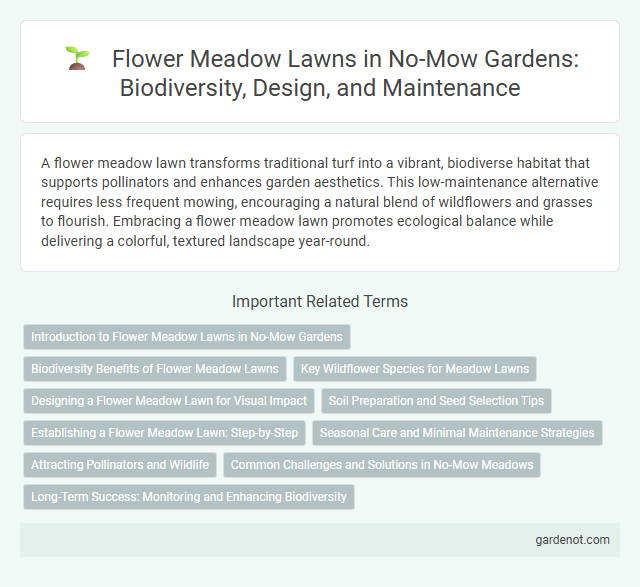A flower meadow lawn transforms traditional turf into a vibrant, biodiverse habitat that supports pollinators and enhances garden aesthetics. This low-maintenance alternative requires less frequent mowing, encouraging a natural blend of wildflowers and grasses to flourish. Embracing a flower meadow lawn promotes ecological balance while delivering a colorful, textured landscape year-round.
Introduction to Flower Meadow Lawns in No-Mow Gardens
Flower meadow lawns in no-mow gardens create vibrant, low-maintenance landscapes by replacing traditional turfgrass with diverse native wildflowers and grasses. These lawns support pollinators, enhance biodiversity, and reduce water and mowing requirements significantly. Emphasizing sustainable gardening practices, flower meadow lawns contribute to ecological health while delivering beautiful, natural aesthetics year-round.
Biodiversity Benefits of Flower Meadow Lawns
Flower meadow lawns significantly enhance biodiversity by providing diverse habitats that support pollinators such as bees, butterflies, and various beneficial insects. These lawns promote native plant growth, increase soil health through natural nutrient cycling, and attract birds and small wildlife, contributing to a balanced ecosystem. Maintaining flower meadows reduces reliance on fertilizers and pesticides, fostering sustainable urban green spaces that improve ecological resilience.
Key Wildflower Species for Meadow Lawns
Key wildflower species for flower meadow lawns include native varieties such as oxeye daisy (Leucanthemum vulgare), wild thyme (Thymus serpyllum), and bird's-foot trefoil (Lotus corniculatus). These species provide essential nectar and habitat for pollinators like bees and butterflies, enhancing biodiversity and ecosystem health. Incorporating diverse wildflowers creates a resilient, low-maintenance no-mow lawn that supports wildlife while maintaining aesthetic appeal.
Designing a Flower Meadow Lawn for Visual Impact
Designing a flower meadow lawn involves selecting a diverse mix of native wildflowers and grasses to create vibrant color contrasts and layered textures that attract pollinators. Incorporating species with staggered blooming periods ensures continuous visual interest from spring through fall. Thoughtful spatial arrangement of plant heights and colors enhances depth and natural flow, resulting in a striking, low-maintenance no-mow alternative.
Soil Preparation and Seed Selection Tips
For a thriving flower meadow lawn, soil preparation starts with testing pH levels to ensure a slightly acidic to neutral range (6.0-7.0), promoting optimal nutrient availability. Loosen the soil to a depth of 4-6 inches and remove weeds to reduce competition, then amend with organic compost to improve drainage and fertility. Select a diverse mix of native wildflower seeds tailored to your region and climate, prioritizing drought-tolerant varieties such as coneflowers, black-eyed Susans, and lupines for low-maintenance growth.
Establishing a Flower Meadow Lawn: Step-by-Step
Establishing a flower meadow lawn begins with selecting native wildflower seeds suited to local soil and climate conditions, ensuring biodiversity and low maintenance. Preparing the soil by removing existing grass and weeds, followed by light tilling, creates an optimal seedbed for germination. Regular watering during the first few weeks promotes seedling growth, while mowing once or twice annually maintains plant health and encourages vibrant blooms.
Seasonal Care and Minimal Maintenance Strategies
Flower meadow lawns thrive with seasonal care that includes early spring mowing to remove dead growth and late autumn cutting to encourage seed dispersal. Minimal maintenance strategies involve allowing native wildflowers to establish naturally, reducing irrigation needs, and avoiding chemical fertilizers to promote biodiversity. This approach supports pollinators and creates a vibrant, low-input landscape throughout the year.
Attracting Pollinators and Wildlife
Flower meadow lawns create a vibrant habitat that attracts a wide range of pollinators, including bees, butterflies, and hummingbirds, essential for ecosystem health. The diverse native wildflowers provide nectar and pollen sources throughout the growing season, supporting the survival and reproduction of beneficial insects. This low-maintenance lawn alternative enhances biodiversity and promotes natural pest control by encouraging a balanced wildlife community.
Common Challenges and Solutions in No-Mow Meadows
Common challenges in no-mow flower meadows include weed invasion, uneven growth, and sparse flowering due to improper seed selection or soil conditions. Solutions involve regular monitoring for invasive species, selecting native wildflower seeds suited to local climates, and implementing seasonal mowing or controlled burning to promote healthy regrowth. Proper soil preparation and occasional fertilization enhance plant diversity and overall meadow resilience.
Long-Term Success: Monitoring and Enhancing Biodiversity
A flower meadow lawn supports long-term success by fostering rich biodiversity through diverse native plant species that attract pollinators and beneficial insects. Regular monitoring of soil health, plant variety, and seasonal growth patterns enables targeted enhancements such as selective reseeding and invasive species control. These practices create a resilient, sustainable ecosystem that thrives with minimal mowing while promoting environmental balance and wildlife habitat.
Flower meadow lawn Infographic

 gardenot.com
gardenot.com